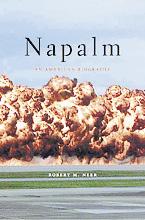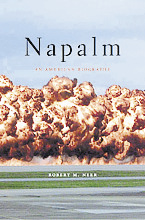 ‘Napalm was born a hero’, argues Columbia University’s Robert Neer about the creation of the sticky, jellied incendiary by US scientists in the Second World War.
‘Napalm was born a hero’, argues Columbia University’s Robert Neer about the creation of the sticky, jellied incendiary by US scientists in the Second World War.
Burning at over 800 ° C, napalm played a decisive role in the Pacific War, with perhaps 100,000 Japanese dying in the infamous napalm attack on Tokyo on 9 March 1945. The US ‘scorched and boiled and baked to death’ more people in that one night than died in Hiroshima and Nagasaki combined, according to US air force general Curtis LeMay.
Its horrific effects on the human body were a psychological weapon as much as anything: after the US started bombing Japan with napalm, around a quarter of the country’s urban population fled their homes.
With ‘the Good War’ a broadly popular war, Neer notes, the scientists who developed napalm, the press and most of the general public raised few moral objections about its use against military and civilian targets. All this changed during the Vietnam War, when a broad-based, inventive protest movement successfully re-branded napalm and made it a pariah.
With the US military dropping a shocking 388,000 tons of napalm on Vietnam between 1963 and 1973, press coverage awakened people in the US to the mass death and destruction being committed in their name. Anti-war activists targeted napalm manufacturers Dow Chemicals. Their campaign was so effective that to this day the company continues to be associated with the burning flesh of Vietnamese.
Neer argues that the protests eventually led to the 1981 Convention on Certain Conventional Weapons Protocol, making napalm ‘a war criminal on probation, its use against concentrations of civilians banned by international covenant and its deployment [against] anyone else tightly restricted by the law of public opinion’.
Surprisingly readable, Neer provides lots of fascinating facts and stories, such as the US’s never-realised plan during the Second World War to turn thousands of bats into suicide bombers bearing tiny napalm bomblets. Or the anti-Vietnam War activists who had the idea of bringing the horrors of napalm back home by dragging napalmed pigs and cows through suburban streets.
At the same time his academic prose is always respectful, giving voice to some of the hundreds of thousands of victims of napalm by quoting numerous eyewitness accounts.
With over 70 pages of in-depth notes, this book is an important resource. Anti-arms trade and anti-war activists will be particularly interested to read about the successful Vietnam War protests against napalm that both informed and then radically changed public opinion.


